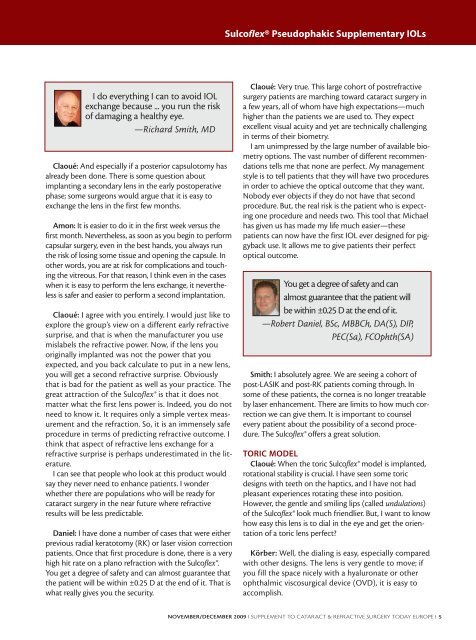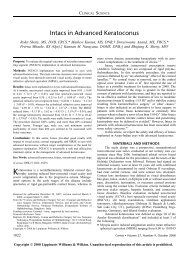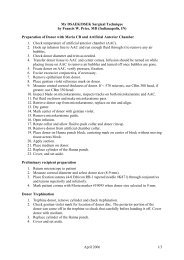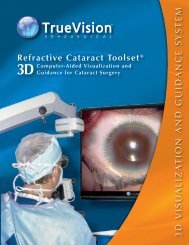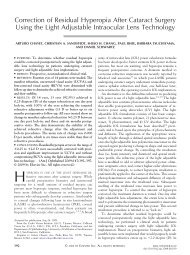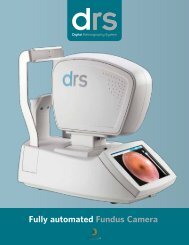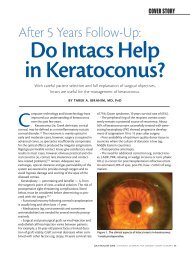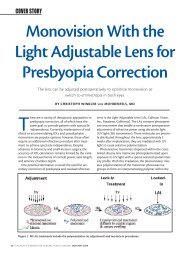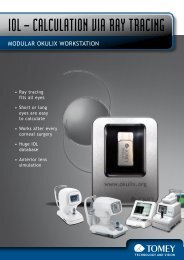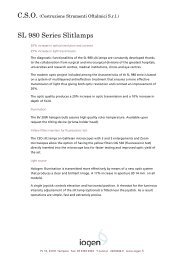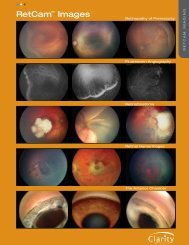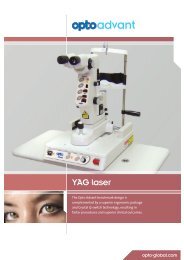Sulcoflex ®Pseudophakic Supplementary IOLs - Iogen
Sulcoflex ®Pseudophakic Supplementary IOLs - Iogen
Sulcoflex ®Pseudophakic Supplementary IOLs - Iogen
You also want an ePaper? Increase the reach of your titles
YUMPU automatically turns print PDFs into web optimized ePapers that Google loves.
I do everything I can to avoid IOL<br />
exchange because ... you run the risk<br />
of damaging a healthy eye.<br />
—Richard Smith, MD<br />
Claoué: And especially if a posterior capsulotomy has<br />
already been done. There is some question about<br />
implanting a secondary lens in the early postoperative<br />
phase; some surgeons would argue that it is easy to<br />
exchange the lens in the first few months.<br />
Amon: It is easier to do it in the first week versus the<br />
first month. Nevertheless, as soon as you begin to perform<br />
capsular surgery, even in the best hands, you always run<br />
the risk of losing some tissue and opening the capsule. In<br />
other words, you are at risk for complications and touching<br />
the vitreous. For that reason, I think even in the cases<br />
when it is easy to perform the lens exchange, it nevertheless<br />
is safer and easier to perform a second implantation.<br />
Claoué: I agree with you entirely. I would just like to<br />
explore the group’s view on a different early refractive<br />
surprise, and that is when the manufacturer you use<br />
mislabels the refractive power. Now, if the lens you<br />
originally implanted was not the power that you<br />
expected, and you back calculate to put in a new lens,<br />
you will get a second refractive surprise. Obviously<br />
that is bad for the patient as well as your practice. The<br />
great attraction of the <strong>Sulcoflex</strong>® is that it does not<br />
matter what the first lens power is. Indeed, you do not<br />
need to know it. It requires only a simple vertex measurement<br />
and the refraction. So, it is an immensely safe<br />
procedure in terms of predicting refractive outcome. I<br />
think that aspect of refractive lens exchange for a<br />
refractive surprise is perhaps underestimated in the literature.<br />
I can see that people who look at this product would<br />
say they never need to enhance patients. I wonder<br />
whether there are populations who will be ready for<br />
cataract surgery in the near future where refractive<br />
results will be less predictable.<br />
Daniel: I have done a number of cases that were either<br />
previous radial keratotomy (RK) or laser vision correction<br />
patients. Once that first procedure is done, there is a very<br />
high hit rate on a plano refraction with the <strong>Sulcoflex</strong>®.<br />
You get a degree of safety and can almost guarantee that<br />
the patient will be within ±0.25 D at the end of it. That is<br />
what really gives you the security.<br />
<strong>Sulcoflex</strong>® Pseudophakic <strong>Supplementary</strong> <strong>IOLs</strong><br />
Claoué: Very true. This large cohort of postrefractive<br />
surgery patients are marching toward cataract surgery in<br />
a few years, all of whom have high expectations—much<br />
higher than the patients we are used to. They expect<br />
excellent visual acuity and yet are technically challenging<br />
in terms of their biometry.<br />
I am unimpressed by the large number of available biometry<br />
options. The vast number of different recommendations<br />
tells me that none are perfect. My management<br />
style is to tell patients that they will have two procedures<br />
in order to achieve the optical outcome that they want.<br />
Nobody ever objects if they do not have that second<br />
procedure. But, the real risk is the patient who is expecting<br />
one procedure and needs two. This tool that Michael<br />
has given us has made my life much easier—these<br />
patients can now have the first IOL ever designed for piggyback<br />
use. It allows me to give patients their perfect<br />
optical outcome.<br />
You get a degree of safety and can<br />
almost guarantee that the patient will<br />
be within ±0.25 D at the end of it.<br />
—Robert Daniel, BSc, MBBCh, DA(S), DIP,<br />
PEC(Sa), FCOphth(SA)<br />
Smith: I absolutely agree. We are seeing a cohort of<br />
post-LASIK and post-RK patients coming through. In<br />
some of these patients, the cornea is no longer treatable<br />
by laser enhancement. There are limits to how much correction<br />
we can give them. It is important to counsel<br />
every patient about the possibility of a second procedure.<br />
The <strong>Sulcoflex</strong>® offers a great solution.<br />
TORIC MODEL<br />
Claoué: When the toric <strong>Sulcoflex</strong>® model is implanted,<br />
rotational stability is crucial. I have seen some toric<br />
designs with teeth on the haptics, and I have not had<br />
pleasant experiences rotating these into position.<br />
However, the gentle and smiling lips (called undulations)<br />
of the <strong>Sulcoflex</strong>® look much friendlier. But, I want to know<br />
how easy this lens is to dial in the eye and get the orientation<br />
of a toric lens perfect?<br />
Körber: Well, the dialing is easy, especially compared<br />
with other designs. The lens is very gentle to move; if<br />
you fill the space nicely with a hyaluronate or other<br />
ophthalmic viscosurgical device (OVD), it is easy to<br />
accomplish.<br />
NOVEMBER/DECEMBER 2009 I SUPPLEMENT TO CATARACT & REFRACTIVE SURGERY TODAY EUROPE I 5


